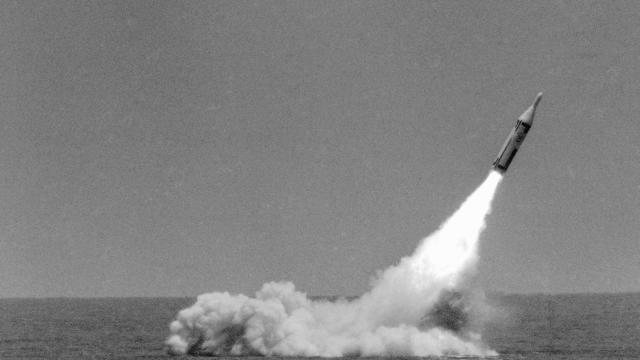More than half a century ago this week, the United States conducted its only farm-to-table nuclear missile test. The test, code-named “Frigate Bird,” involved the launch of a Polaris missile from a submarine carrying a live nuclear warhead. The missile travelled a thousand miles before streaking down on an uninhabited island in the middle of the Pacific Ocean, exploding with the force of 37 Hiroshima bombs.
The United States conducted a staggering 1,030 nuclear weapon tests between 1945 and 1992, the year it ceased testing. The Frigate Bird test, which took place on May 6th, 1962 was the only case in the entire history of the US nuclear arsenal in which a nuclear missile actually delivered its horrifically lethal payload.
Nuclear weapons are dangerous, complicated, and expensive things. A lot can do wrong during tests. Rockets can explode, bombers can crash, and the weapon itself might fizzle out and be a dud. A live nuclear test could also be seen as inflammatory to the other side, in this case the Soviet Union and China. For that reason nuclear warheads—and bombs—were often tested separately from the system designed to carry them, in the atmosphere and later underground. Even today, although the United States no longer tests nuclear weapons it still tests delivery systems; the most recent test on May 1st involved a Minuteman III intercontinental ballistic missile launched from Vandenberg Air Force Base in California.
U.S. nuclear weapons and delivery systems generally worked as advertised, and it was generally seen as unnecessary to perform a live ballistic missile test. The assumption was always that if you test the warhead and the delivery system separately, there is no reason to assume they would not work together during a civilisation-ending nuclear war. It’s like enjoying peanut butter and enjoying chocolate separately from another, and assuming that both would taste great together. If apocalyptic nuclear death is your sort of favourite dessert concoction.
But there was one time—just once—when the Pentagon decided to try peanut butter and chocolate at the same time. On May 6th, 1962, at 11:30 GMT, the United States Navy submarine USS Ethan Allen launched a Polaris A1 ballistic missile. The missile carried a live thermonuclear warhead, with a yield set for the equivalent of 600 kilotons of TNT. (For comparison’s sake the bomb dropped on Hiroshima was approximately 16 kilotons.)
The Polaris missile missile rose from its launch tube behind Ethan Allen’s sail and flew straight up, carrying its nuclear payload. The missile successfully inserted its Mk 1 reentry vehicle into orbit, and the RV came crashing down to earth 12.5 minutes later, a thousand miles away, the W-47Y1 warhead nestled safely inside. The warhead, set for airburst, detonated at an altitude of 11,000 feet. The test was a complete success, observed by other submarines operating nearby.
Today in 1962, the US conducted Frigate Bird, the only US nuclear proof test of a live warhead on an operational ballistic missile. In the Pacific, the USS Ethan Allen (SSBN 608) launched a Polaris A1 SLBM toward Christmas Is. (Kiritimati). Yield of the W47Y1 warhead was ~600kt. pic.twitter.com/ws9hkjouL1
— Stephen Schwartz (@AtomicAnalyst) May 6, 2019
The United States ended nuclear testing in 1996 with the signing of the Comprehensive Test Ban Treaty. The end of the Cold War, and confidence that America’s nukes worked, made nuclear tests unnecessary. Ironically some of that confidence likely came from the Frigate Bird test, which validated all of the concepts of a nuclear ballistic missile, culminating in a fireball that spread out across the Pacific Ocean 57 years ago today.
The test was a success, and when the time it gave arms control advocates the ammunition needed to suggest maybe we don’t need to test nuclear weapons anymore.
